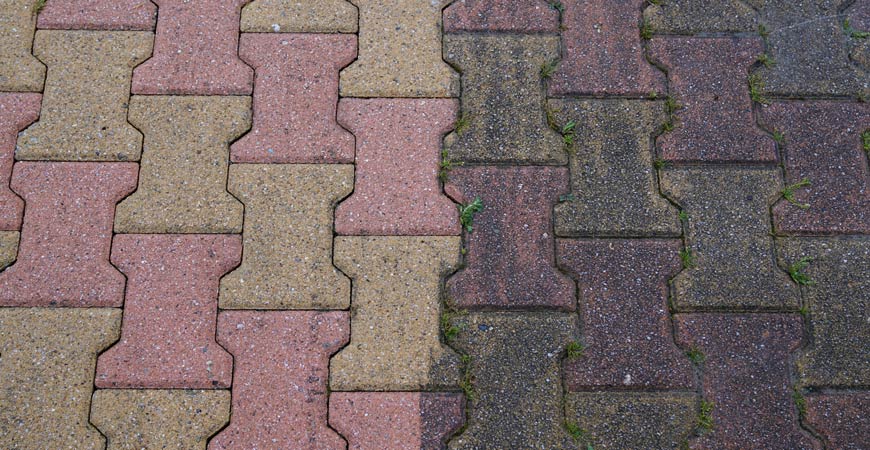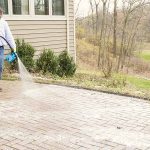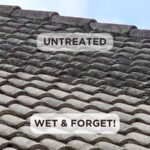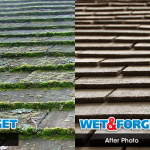How To Clean A Driveway

Your driveway is like a red carpet for your car. It’s a platform for showing off your vehicle as it slowly works its way — occasionally pausing for photos, of course — to your garage.
But if your driveway is stained, dirty, or otherwise unsightly, what exactly are you showing off? Instead of hiding from your neighbors and the paparazzi, reclaim your glamorous status by reading our guide on how to clean your driveway.
What Gets Your Driveway So Dirty?
Driveways are designed to get beat up. A fleet of automobiles regularly pulls in and out, and wind, rain, and the sun regularly beat on the pavement’s surface.
So, it shouldn’t be too surprising that sometimes driveways get dirty. Specifically, driveways are vulnerable to a variety of potential hazards:
- Black algae
- Dirt and mud
- Grease and oil
- Green algae
- Moss
The organic growths listed here thrive in damp, dark environments. If your driveway sits in the shade or you live in a humid area, you are more likely to experience these issues.
On the other hand, grease and oil stains are common on driveways, especially if you keep a vehicle parked outside instead of in your garage. If your driveway is made from asphalt, they may be less noticeable, but they still require cleaning.
How Often Do You Need to Clean Your Driveway?
Like your deck, your driveway deserves some amount of regular maintenance. That doesn’t mean you have to prepare yourself for a deep clean every week, but you should sweep away any piles of dirt, leaves, or other loose debris whenever you notice them beginning to accumulate.
Otherwise, consider deep cleaning your driveway at least once a year.

How to Clean a Driveway
The first step in cleaning your driveway is identifying what exactly you’re trying to remove. In some cases, a stain that looks like dirt may turn out to be mold and mildew, especially if scrubbing fails to remove it.
Removing stains caused by organic growth, like mold and mildew, is relatively easy. There’s no real need for any specialized tools or homemade concoctions.
Instead, pull out your bottle of Wet & Forget Outdoor. If your driveway is on the larger size, Wet & Forget Xtreme Reach™ Hose End can help you tackle the job quickly and effectively.
The formula is non-acidic and bleach-free. That makes it safe to use on almost any outdoor surface, including those commonly used on driveways:
- Asphalt
- Brick
- Concrete/Stamped concrete
- Stone
- Stained or painted surfaces
Additionally, the bottle offers unique features that make cleaning your driveway easy. Each one has enough formula to cover up to 2,000 square feet, and the Xtreme Reach™ Nozzle can help the spray reach distances of up to 30 feet.
To get started, first check your weather forecast. Wet & Forget Xtreme Reach™ Hose End works best on days without rain or wind and when temperatures are at least 55 degrees Fahrenheit.
Once you’ve found the ideal day, follow these steps to clean your driveway:
- Screw your hose into the end of the Xtreme Reach™ Nozzle.
- Attach the fan tip. This tip is ideal for large surfaces.
- Turn the dial counterclockwise to its On setting.
- Thoroughly spray your driveway until the entire surface is covered.
- Repeat once a year or as needed.
The Wet & Forget Outdoor formula will gently clean your driveway over time by working with wind and rain. There’s no need to rinse, scrub, or invoke any sweat on your part.
Green algae stains should only take a couple of weeks to disappear, while black stains may take a few months. Particularly stubborn stains may need another Wet & Forget Outdoor application a month or two later. 
How to Remove Grease and Oil Stains From Your Driveway
While Wet & Forget Outdoor can help with stains caused by organic growth, it isn’t designed to remove grease or oil stains. However, there are plenty of easy solutions to remove these unsightly discolorations.
If you own a cat or weirdly collect kitty litter, you already have the primary tool you need to get the job done. If you’re a dog person, all you need to do is pick up a package of clay-based kitty litter to get started.
Simply spread the kitty litter on top of the stains. Wait a few hours for it to absorb as much of the grease and oil as possible.
When you’re done waiting, sweep up the kitty litter. The surface stains should be gone.
How to Remove Dirt and Mud From Your Driveway
You can clean dirt and mud from your driveway with only a stiff-bristled broom and your garden hose.
First, use your broom to sweep away loose dirt and rocks. If you have any caked-on mud, use your hose to soak the area.
After letting the mud dampen for a few minutes, use your broom to vigorously scrub the area. Depending on how set the dried mud is, you may need to apply more water to let it loosen up.
Should You Power Wash Your Driveway?
A power washer is everyone’s favorite outdoor tool. However, shooting water at very high velocities also has its clear downsides.
You can damage your driveway’s surface and make it easier for stains to set deeper. This, in turn, will make it more difficult to remove stains later on.
What Else Should You Avoid When Cleaning Your Driveway?
Bleach is another cleaning temptation. However, when you use bleach, you will be bleaching your driveway. That may seem obvious, but using bleach can cause colors on your driveway to fade and can cause the surrounding lawn area to die.
Part of the concern with bleach is its naturally high pH level. It’s more alkaline, and that can cause your driveway’s surface to fade, as well as kill nearby grass or plants.
Wet & Forget Outdoor products, on the other hand, has a pH level of 8. Since it’s more pH neutral, it’s safe to use on virtually any outdoor surface.
Where Can You Get Wet & Forget Products?
Cleaning your driveway has never been easier than with Wet & Forget Outdoor products at your side. You can find them either online or at your local retailer.






